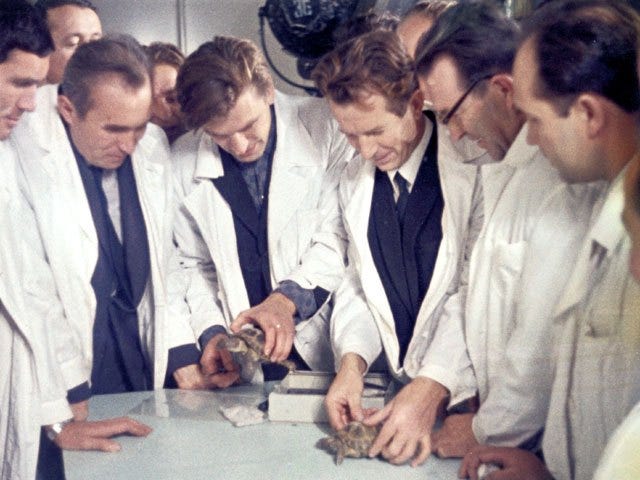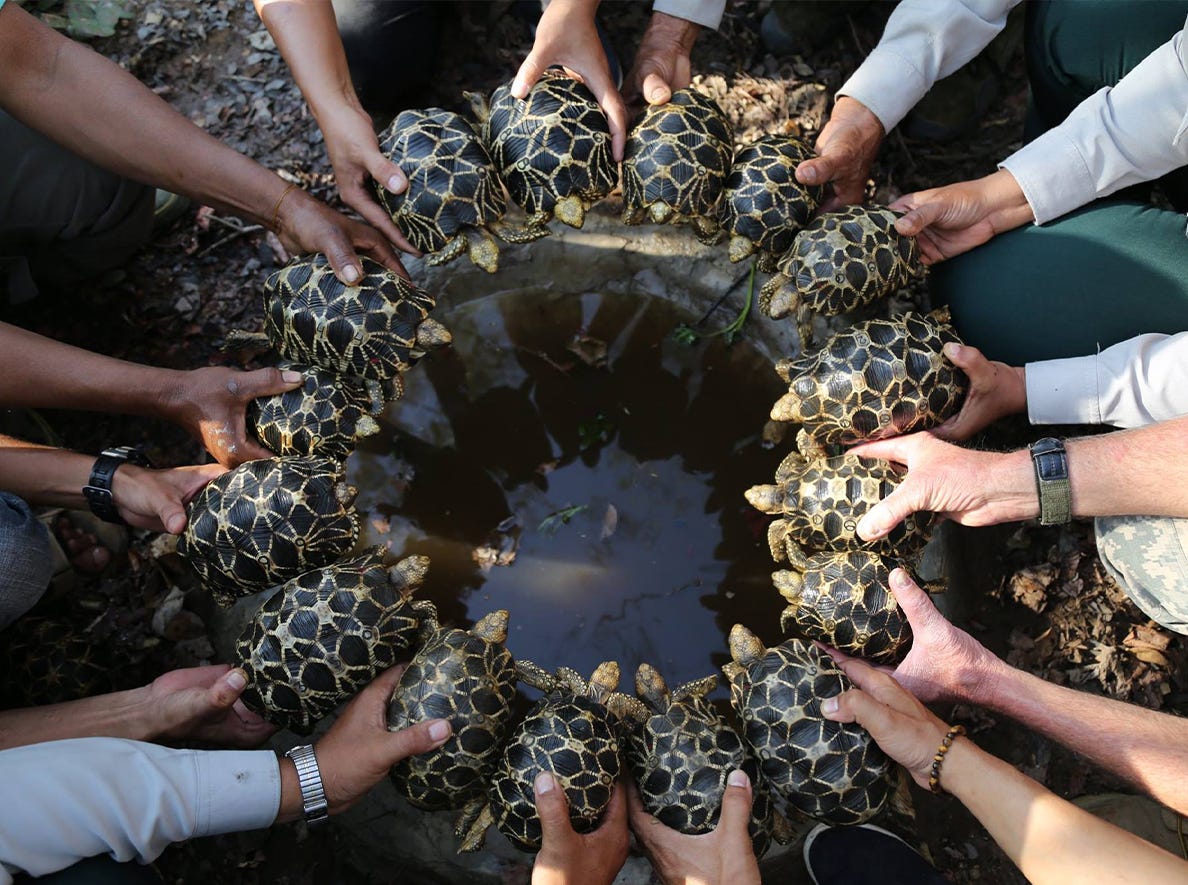The Weekly Anthropocene Reviews: Of Time and Turtles by Sy Montgomery
A fascinating saga of turtles and the humans who devote their lives to protecting them
Of Time and Turtles is the latest work by Sy Montgomery, on sale September 19, 2023. This writer can make no claim of objectivity here: after being inspired by Sy Montgomery’s writing since childhood, interviewing her for this newsletter in early 2023, and making a map of her many fascinating travels, they were pretty certain that this book was going to be excellent. And it was—but in a fascinatingly unexpected way.
The first expectation the reader has of a book called Of Time and Turtles is that it will contain interesting facts about turtles, and this it does, in bountiful plenty. The book is full of riveting sentences that leave the readers with a slightly expanded understanding of the world they live in. Sentences like:
“Turtles are as old as the first dinosaurs, older than the first crocodiles, and have been around for over 250 million years.”
“‘Did you know…the first animals to orbit the moon were tortoises?’ (They were a pair of unnamed steppe tortoises aboard the Soviet Zond 5 space probe in September 1968).”
“A turtle who recently died at age 288 was alive when George Washington was born, when homes were lit by candles, medicine largely consisted of enemas and bloodletting, and mental illness was treated with powder made from the hooves of moose. Another turtle had a baby at age 140.”
“The major organs of a hundred-year-old turtle…are indistinguishable from those of a teenager of the same species…Their hearts can cease beating for long periods without damage. In species that hibernate (in reptiles, it’s called brumation), turtles can survive buried in mud for months without taking a breath.
“Most brumating turtles spend the winter at temperatures just above freezing. (Owners are sometimes advised to overwinter their box turtles in a container of dirt in a spare refrigerator.) Russian tortoises, who survive in the icy steppes of Central Asia, may construct burrows six feet deep for the purpose.”
“Then, from an opening on the underside of his tail, Chunky Chip extrudes a huge purple, seven-inch long tubiform appendage tipped in what looks like a club…And yes, all turtle penises are shockingly huge, sometimes half the length of the carapace.”
“Some turtles could even help us cure cancer. Asian mayapples, the source of etoposide, used to treat lung and testicular cancer, have been harvested almost to extinction. American mayapples provide an effective substitute, though the plant’s seeds are extremely difficult to propagate—unless the seeds are ingested and excreted by box turtles.”
The unexpected part is that perhaps the most powerful lesson from this book devoted to the lives of turtles is about humans. A subset of humans deeply care about other creatures’ lives and well-being, and are willing to go to extraordinary lengths to help them. Ordinary people see their animal neighbors’ lives being upended by human actions (from car collisions to the illegal pet trade to climate change), their ancient instincts no longer enough for survival in the fast-warming, human-dominated world of the Anthropocene, and they think, We can help. We won’t let them die.
In Massachusetts, an extraordinary couple, Natasha and Alexxia, founded the Turtle Rescue League out of their house (originally apartment!) on a shoestring budget, and now devote their lives to it. Over the past decade, they have essentially created from scratch, on their own initiative as turtle-loving private citizens, an entire healthcare infrastructure devoted to the wellbeing of turtles in the New England area. They take on every task from first-responders to long-term caregivers, springing into action to retrieve turtles struck by cars, chewed by dogs, or abandoned in the street by their owners, then piecing together their injuries (often repairing broken shells with literal tape and glue), and caring for them for as many months or years as it takes for them to recover or die. Here’s a video from their website:
Of Time and Turtles narrates Sy’s visit to their HQ:
“Parked in the drive are a white smart car and a black Scion. Both are mounted with strobe lights—like the ambulances they are. Emblazoned with the Turtle Rescue League logo, and with stickers urging fellow motorists, STOP FOR TURTLES IN THE ROAD-HELP THEM GET ACROSS, the cars serve as emergency vehicles for transporting injured turtles to the thousand-square-foot turtle hospital that occupies the basement of the home…”
“Alexxia had projected a slide of one of their patients, a female snapping turtle. The entire first third of her shell was shattered, three of her legs were smashed, one eye was gone; she had been lying on the side of the asphalt road where she’d been hit, cooking in the sun, for hours. But two years later, she was returned to the wild, healed.”
“We got five of the most endangered sea turtles in the world off the beach [during a storm],” Alexxia reminds us. “They definitely would have died. And now they definitely will survive.”
And on a global scale, the reader is introduced to the Turtle Survival Alliance (TSA)- a higher-budget international version of Alexxia and Natasha’s New England efforts, focused on protecting and captive-breeding some of the most critically endangered turtle species in the world. Their Turtle Survival Center occupies a well-guarded location in South Carolina, defending their charges from the illegal wildlife trade while coordinating turtle-rescue operations around the world. The book makes them sound like the secret government organization S.H.I.E.L.D. from the Marvel Cinematic Universe, only focused on turtles instead of superheroes.
“Earlier that day [at the center]…Cris had introduced us to the Chinese yellow-headed box turtles. They were about to emerge from brumation. Just one was already awake: Her six-inch long brown shell was submerged in her pond; her golden head was out of the shell, but still covered by water. Her species is extinct in the wild, Cris told us; the last wild one known to be collected was bought at a market in 2015. “These animals are absolutely irreplaceable. There may be only one hundred wild-caught adults left on Earth,” Cris said.”
“Coils of razor wire top the eight-foot-tall perimeter fence, augmented by two strands of electric wire. Motion sensors, lights, alarms, and a team of vocal, vigilant Rottweilers guard the property. Sensors are set to detect any glass that is broken, and sirens wail if anything happens that is out of the ordinary. Three employees live on-site or next door, and Cris notes, “We all have a lot of firearms.” Everyone who visits must disable the GPS on their mobile phones so the location of the Center remains secret.”
“A single Yunnan box turtle could command $200,000 on the black market.”
“We’ve joined TSA keepers…in one of the center’s outdoor ponds…Fish and crawdads and a number of large jumping spiders share the water with us too. But there should be, as well, somewhere in this pond, twenty-six roughly one-pound, critically endangered Chinese red-necked pond turtles, whose home range is now restricted to only two spots in China and possibly one in Vietnam.”
“In 2008, TSA took over the husbandry of the animals, and immediately the turtles started laying eggs—250 of them. As of February 2015, the consortium had bred 15,000 baby stars and released 2,100. Now they are breeding in the wild again…The Burmese star tortoise’s success story can be credited to many creative components. To protect the released turtles from poachers, their shells were tattooed with a message in Burmese-’Harm me and harm comes to you’-which ruined the turtles’ uses both as ornaments and as good-luck medicine.”
“In 2015, Philippine wildlife authorities confiscated 3,800 critically endangered Palawan forest turtles from a single wildlife trafficker-more of the species than were thought to remain in the wild. Within seventy-two hours of the discovery, TSA [Turtle Survival Alliance] assembled a team of experts from three continents to feed, house, and heal them.”
“In April 2018, ten thousand endangered radiated tortoises were seized from a single house in Madagascar, where they were packed like cobblestones, dehydrated and hungry, many with smashed shells and injured eyes. Again, TSA experts assembled keepers, vets, and construction crews to help. Six months later, authorities intercepted a shipment of seven thousand more.”
When the reader has finished Of Time and Turtles, they will have met many fascinating turtles, but also several truly extraordinary human beings. Volunteers who brave a “bomb cyclone” snowstorm during a New England winter to scour Cape Cod’s beach for cold-shocked critically endangered Kemp’s ridley sea turtles, then haul a sledge full of the survivors they find over wet sand for miles. Conservationists who devote their lives to caring for turtles that are both critically endangered and highly in-demand by the illegal wildlife trade, arming themselves to defend their chelonian dependents. These are Good people with a capital G. Reading about their work makes one want to stand up and cheer.
This writer’s ultimate takeaway from Of Time and Turtles is a strangely contrarian-seeming, yet profoundly inspiring one: The world is full of heroes. Brave, selfless, decent people. People who dedicate their free time, spend their resources, and even risk their lives to save innocent creatures, or even for a chance at saving innocent creatures. You don’t see them in the news that often. But you do see them in the pages of Sy Montgomery’s books. Read Of Time and Turtles, and it will restore some measure of your faith in humanity.









1. It's really nice to hear about humans doing some good for a change
2. You really understand how to get me interested in a book
Well done!
I am looking forward to this book so much! Thank you for reviewing the book. Turtles are fascinating, but I love even more the instincts they can bring out in humanity!